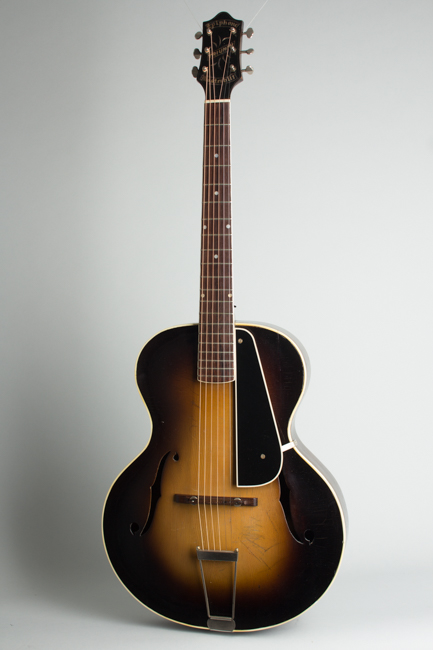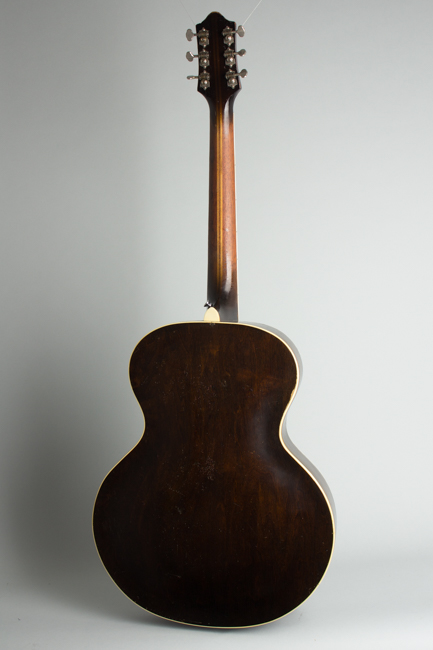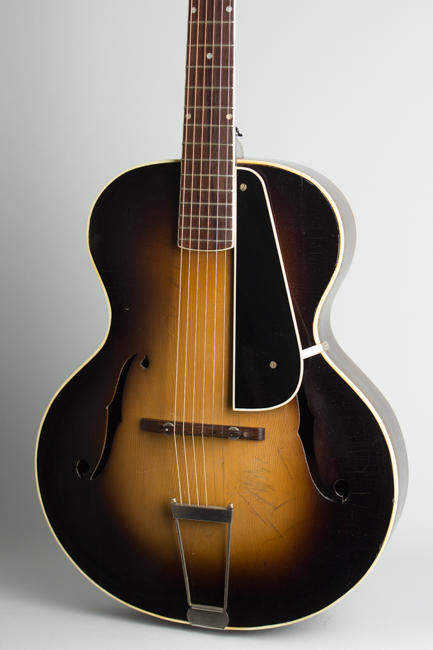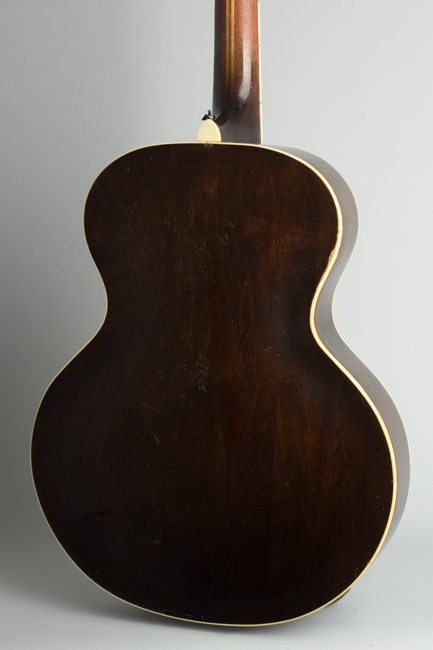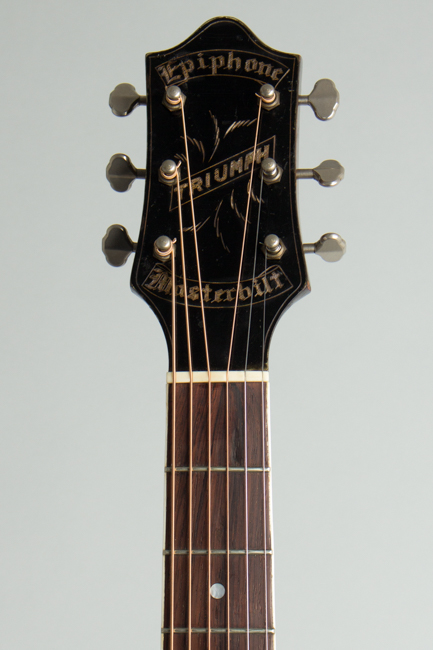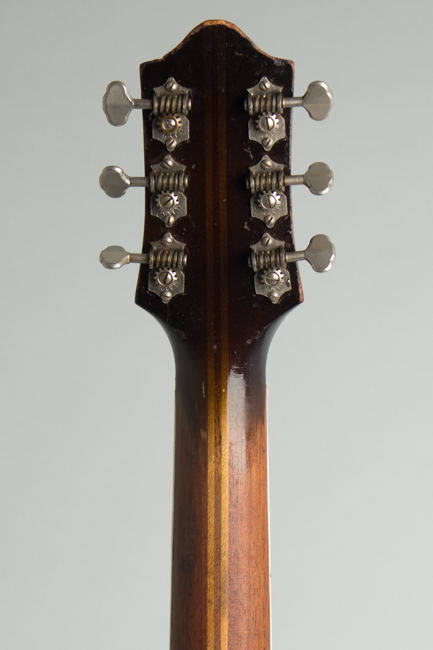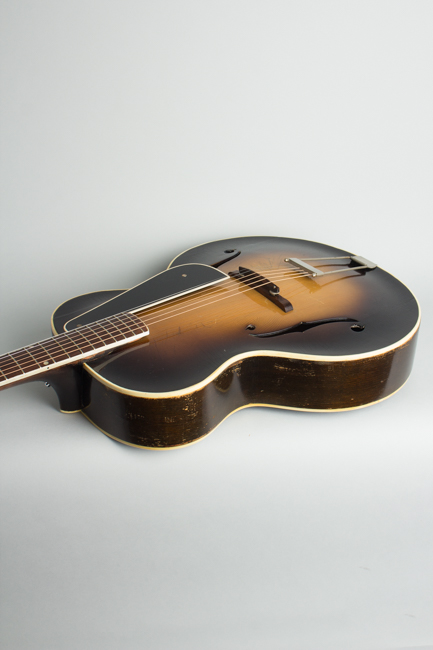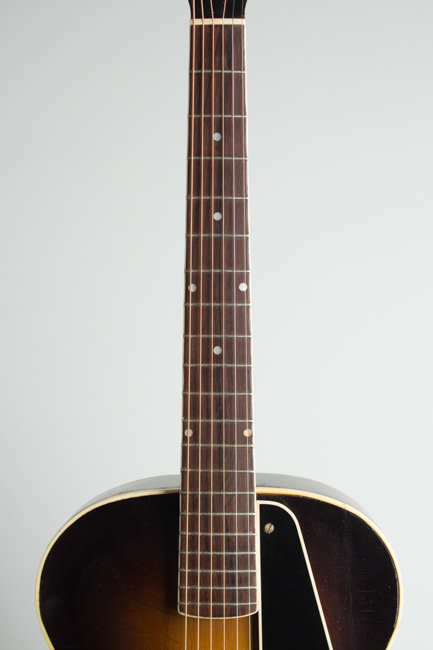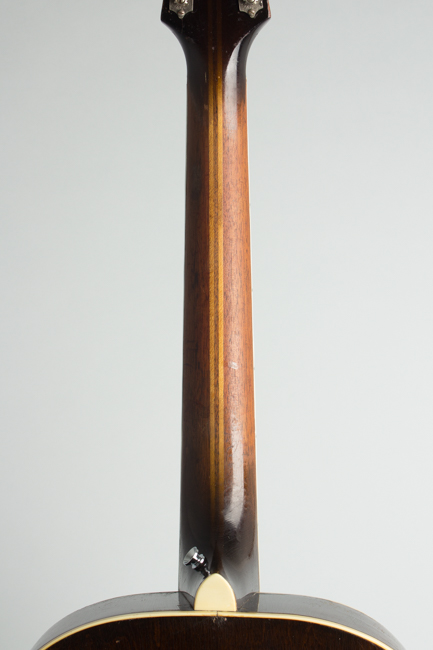Epiphone Triumph Masterbilt Arch Top Acoustic Guitar (1933)
This item has been sold.
Item # 9530
Prices subject to change without notice.
Epiphone Triumph Masterbilt Model Arch Top Acoustic Guitar (1933), made in Long Island City, NY, sunburst top, dark back and sides finish, laminated maple back and sides, solid carved spruce top; laminated mahogany neck with rosewood fingerboard, black tolex hard shell case.
This lovely Epiphone Triumph from 1933 is an early example of this long-running model with a number of older features typical of the "Masterbilt" era. This instrument represents the second version of the Triumph, introduced in 1931 and recently enlarged to a 16 3/8" body from the original 15 1/12". This model was the lowest grade professional guitar in Epiphone's line, a relative bargain at $125 and a real workhorse for depression era players who could not afford the top-line $275 Deluxe or Gibson L-5. The triumph changed features often in this period and this is a fairly rare variation.
The top is single bound and finished in a fairly somber brown sunburst, the back and rims finished in a dark stain overall. The center-peak headstock is faced with engraved celluloid with "Epiphone Triumph Masterbilt" incised in a banner design. The 5-piece laminated mahogany neck is fairly wide with a noticeable taper, the medium-shallow "C" profile hinting at a "V" in the lowest position. The carved rosewood adjustable bridge and simple tailpiece are common to most Epiphone models in this period. The single bound pickguard appears in the original style, but may be a nicely done reproduction.
In 1933 Epiphone, Inc. was headed up by its namesake Epaminondas ("Epi") Stathopoulo. By all accounts, he was an extremely fastidious and dedicated man who personally inspected every instrument. All high-end carved-top Epiphone guitars are fine instruments, but the earlier models produced under his watch are among the very best and were often preferred by the era's top players to anything else available.
Not long after this guitar was made, the Stathopoulo family moved their guitar-building operation from Long Island City to the second floor of a large loft building on West 14th street where Epiphone, Inc. would operate an integrated factory and showroom in the heart of swing-era New York. This "second generation" Epiphone Masterbilt Triumph has some small changes from the initial 1931 models but still dates to the period before the company enlarged and completely redesigned the model in response to arch-rival Gibson's "Advanced" line in 1935. These original high-end Epiphone Masterbilt archtop guitars were very popular among professional users when new, but many were played for decades and nice examples are hard to find today.
Overall length is 41 1/4 in. (104.8 cm.), 16 3/8 in. (41.6 cm.) wide at lower bout, and 3 3/8 in. (8.6 cm.) in depth, measured at side of rim. Scale length is 25 1/2 in. (648 mm.). Width of nut is 1 11/16 in. (43 mm.).
This guitar has seen some action over the decades but presents very well, looking and playing fine while showing a number of old repairs nicely executed and unobtrusive. The top has a number of repaired spruce grain cracks, including coming down from each F-hole to the bottom rim, on the upper treble bout down past the waist and a smaller area on the upper waist. There is a small patch to the lower end of the treble side F hole. All these are very neatly sealed up and the repairs well hidden under some finish touch-up, really noticeable only on fairly close inspection. There is a long rim crack through the endpin that is solid but not as well concealed. The top of the headstock face has a bit of errant glue damage around the "Ep" of the logo.
The guitar has had the neck reset and been neatly refretted with the binding on the neck replaced. The top was rebound as well, while the back binding appears original. The celluloid used on New York guitars from the 1930's thru the 1960's has often deteriorated badly over the years so this is relatively common. The finish shows typical checking and general wear including scratches, scuffs and dings but is not worn too heavily anywhere but the back of the neck, where some spots are down to the wood.
All hardware is original except for the tuners, which are old but later period Grover G-98's. A strap button has been added to the heel. The guitar has a powerful sound, incisive without being overly brash. This punch is typical of early Epiphones, and a big part of their initial success. This is a lovely old veteran plays very well, showing its scars but still a wonderful survivor of swing era New York. Very Good + Condition.
This lovely Epiphone Triumph from 1933 is an early example of this long-running model with a number of older features typical of the "Masterbilt" era. This instrument represents the second version of the Triumph, introduced in 1931 and recently enlarged to a 16 3/8" body from the original 15 1/12". This model was the lowest grade professional guitar in Epiphone's line, a relative bargain at $125 and a real workhorse for depression era players who could not afford the top-line $275 Deluxe or Gibson L-5. The triumph changed features often in this period and this is a fairly rare variation.
The top is single bound and finished in a fairly somber brown sunburst, the back and rims finished in a dark stain overall. The center-peak headstock is faced with engraved celluloid with "Epiphone Triumph Masterbilt" incised in a banner design. The 5-piece laminated mahogany neck is fairly wide with a noticeable taper, the medium-shallow "C" profile hinting at a "V" in the lowest position. The carved rosewood adjustable bridge and simple tailpiece are common to most Epiphone models in this period. The single bound pickguard appears in the original style, but may be a nicely done reproduction.
In 1933 Epiphone, Inc. was headed up by its namesake Epaminondas ("Epi") Stathopoulo. By all accounts, he was an extremely fastidious and dedicated man who personally inspected every instrument. All high-end carved-top Epiphone guitars are fine instruments, but the earlier models produced under his watch are among the very best and were often preferred by the era's top players to anything else available.
Not long after this guitar was made, the Stathopoulo family moved their guitar-building operation from Long Island City to the second floor of a large loft building on West 14th street where Epiphone, Inc. would operate an integrated factory and showroom in the heart of swing-era New York. This "second generation" Epiphone Masterbilt Triumph has some small changes from the initial 1931 models but still dates to the period before the company enlarged and completely redesigned the model in response to arch-rival Gibson's "Advanced" line in 1935. These original high-end Epiphone Masterbilt archtop guitars were very popular among professional users when new, but many were played for decades and nice examples are hard to find today.
Overall length is 41 1/4 in. (104.8 cm.), 16 3/8 in. (41.6 cm.) wide at lower bout, and 3 3/8 in. (8.6 cm.) in depth, measured at side of rim. Scale length is 25 1/2 in. (648 mm.). Width of nut is 1 11/16 in. (43 mm.).
This guitar has seen some action over the decades but presents very well, looking and playing fine while showing a number of old repairs nicely executed and unobtrusive. The top has a number of repaired spruce grain cracks, including coming down from each F-hole to the bottom rim, on the upper treble bout down past the waist and a smaller area on the upper waist. There is a small patch to the lower end of the treble side F hole. All these are very neatly sealed up and the repairs well hidden under some finish touch-up, really noticeable only on fairly close inspection. There is a long rim crack through the endpin that is solid but not as well concealed. The top of the headstock face has a bit of errant glue damage around the "Ep" of the logo.
The guitar has had the neck reset and been neatly refretted with the binding on the neck replaced. The top was rebound as well, while the back binding appears original. The celluloid used on New York guitars from the 1930's thru the 1960's has often deteriorated badly over the years so this is relatively common. The finish shows typical checking and general wear including scratches, scuffs and dings but is not worn too heavily anywhere but the back of the neck, where some spots are down to the wood.
All hardware is original except for the tuners, which are old but later period Grover G-98's. A strap button has been added to the heel. The guitar has a powerful sound, incisive without being overly brash. This punch is typical of early Epiphones, and a big part of their initial success. This is a lovely old veteran plays very well, showing its scars but still a wonderful survivor of swing era New York. Very Good + Condition.
